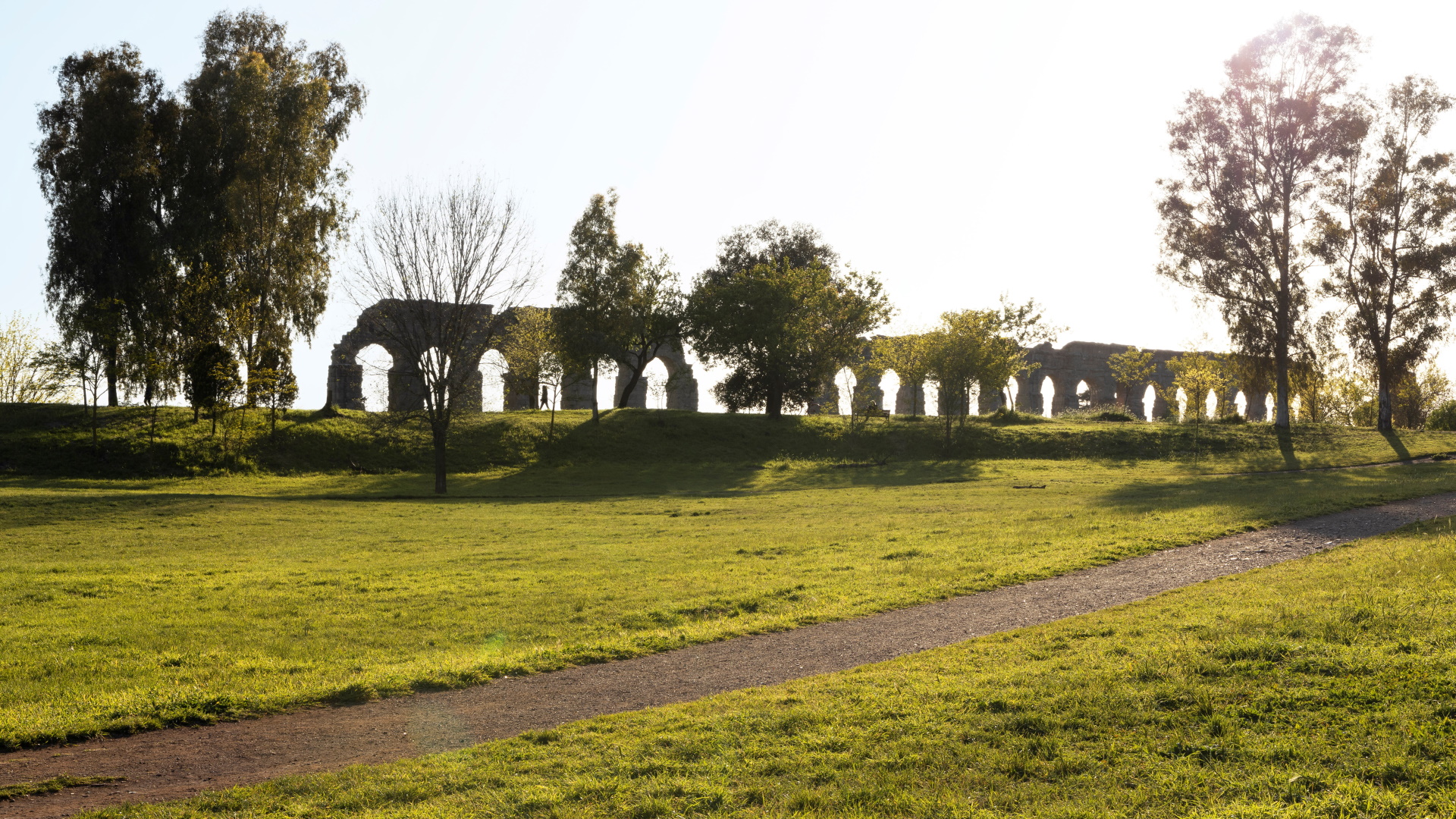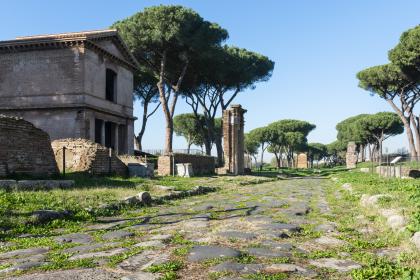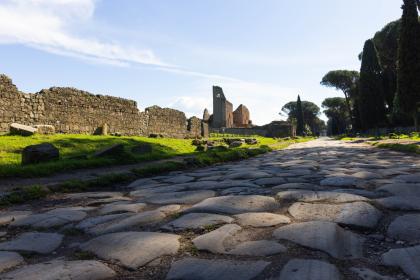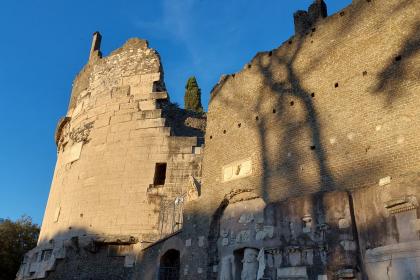
Seductive landscapes of wild and still unspoiled nature
It is one of the most fascinating parks in Rome and is enclosed between Via Appia and Via Tuscolana. It extends for about 240 hectares, within the landscape attractions of the Roman countryside up to the Castelli. The atmosphere of this park seems suspended in time and is especially enjoyable in the pink light of the sunset when the imposing arches of the Claudio and Felix aqueduct stand out against the sun in all their evocative beauty, framed by pine trees.
Rich in history, the Park of the Aqueducts is one of the green lungs of the city and is part of the Parco Regionale Suburbano dell'Appia Antica. It was the fundamental point of connection of the water network of ancient Rome, where the aqueducts that supplied the large patrician villas, the spas, and fountains of Rome, intersected, joined, and overlapped.
The same seductive landscapes of wild and still unspoiled nature have enchanted great artists, writers, and landscape painters. In the romantic age, the young aristocrats undertook the Grand Tour, the necessary journey to learn to live.Walking inside the park means allowing yourself a few hours of complete relaxation away from the chaos of the city, among paths lined with streams, waterfalls, trees, and pastures, and obviously immersing yourself in the atmosphere of Rome of the past.
In the area, there are seven aqueducts: Anio Vetus, Anio Novus, Aqua Marcia, Aqua Tepula, Aqua Iulia, Aqua Claudia, and the still-functioning Felix Aqueduct. It was built in 1585 by Pope Sixtus V on the arches of the Marcio Aqueduct. In the same area, there are also other fascinating ancient buildings, such as the Villa delle Vignacce, the Casale di Roma Antica, and the Villa dei Sette Bassi.
Today, most of the conduits are no longer visible. Many had an underground route, plus, the more recent ones have been superimposed overtime on the external structures of the oldest aqueducts.
Anio Vetus
Built between 272 and 269 BC, it was about 64 kilometers long and moved 180 thousand cubic meters of water a day. Its conduit was underground and only a short stretch of it emerged near Via del Quadraro. After that of the Appian water, it is the second oldest Roman aqueduct, but it is the first to take water from the Aniene river, of which it follows the path to Tivoli.
Aqua Marcia
It is the aqueduct with the longest route: 91 kilometers and a flow rate of 190 thousand cubic meters per day that reached the Capitol. It was built in 144 BC by the praetor Quinto Marcio. Its waters came from a source located on via Tiburtina Valeria, between Arsoli and Agosta. This aqueduct was the first to use the arch system, two sections of which are still well preserved behind the Casale di Roma Vecchia. The rest of the structure was obscured by the Felice aqueduct, which follows its path.
Aqua Tepula
It was built in 125 BC. C. by the consuls Gneo Servilio Cepione and Lucio Cassio Longino. It drew its warm waters - 16/17 degrees - from an underground conduit at the foot of the Alban Hills, between Grottaferrata and Marino. Part of it was visible at the intersection between via Latina and via Appia Nuova. Its structures, as for the Marcio aqueduct, were incorporated into the Felice Aqueduct.
Aqua Julia
It was built in 33 BC by Consul Agrippa. Its waters were transported to an underground conduit from the Squarciarelli sources, near Grottaferrata. Its structures are no longer visible because they were destroyed or used for the Felix Aqueduct.
Claudio and Anio Novus
At the time of their construction started by Emperor Caligula in 38 AD and completed by Claudius in 52 AD, Rome already had over 1 million inhabitants and a massive water requirement for numerous daily public and private activities. On their way through the park, the two ducts are incorporated and overlapped in the same arched structure. But, while Anio Novus extracted its waters from the Anene, Claudio drew them from the Cerulea and Curzia springs, not far from the Marcia water. The Claudio Aqueduct was about 68 km long and had a capacity of 185 thousand cubic meters of water per day. 155 pylons supported its arches up to almost 28 meters high. It crossed the Marcio aqueduct and then deviated towards the Appia Antica to cross it again near Tor Fiscale. The so-called Anio Novus, to distinguish it from the Vetus one, was 87 km long: 73 km underground and 14 above ground. Its course was parallel to that of the Claudio aqueduct overlapping it in the Capannelle area.
Aqua Felix
Built by Pope Sixtus V, it took its waters from the sources of Pantano Borghese on via Prenestina. In an underground conduit up to the Casale di Roma Vecchia, it continues to the Moses Fountain on Largo di Santa Susanna. Its arches are clearly visible up to Porta Furba. From Via del Mandrione to Porta Maggiore, it overlaps the Claudio Aqueduct.
The Villa delle Vignacce, the Casale di Roma Vecchia and the Villa dei Sette Bassi
The Villa delle Vignacce is one of the biggest suburban villas in this area. Datable between the II and IV centuries AD, it was probably built by Quinto Servilio Pudente, a wealthy masonry producer from the age of Hadrian (117-138 AD), as the molds and lead pipes exhibiting his name seem to prove. Its ruins connect it to a large spa complex and a cistern supplied by the nearby Marcio Aqueduct.
It was named Casale di Roma Vecchia after the nearby Villa dei Sette Bassi. In the 18th century, it was believed that its ruins belonged to an ancient city similar to Rome, given the vastity of the area. The Casale consists of a farmhouse, probably located on a 13th-century old post office. It was strategically positioned between the Aqua Claudia and Marcia aqueducts.
The Regional Park of the Appian Way

 Condividi
Condividi
The Appian Way

 Condividi
Condividi
The Mausoleum of Caecilia Metella

 Condividi
Condividi
Information
Aperto dall'alba al tramontoPunto Info Acquedotti: aperto tutte le domeniche.Chiuso gennaio, febbraio, luglio e agostoInformazioni e vendita gadgets e pubblicazioni del Parco.p.grella@parcoappiaantica.it
 Condividi
Condividi
Location
To find out about all accessibility services, visit the Rome accessible section.











































